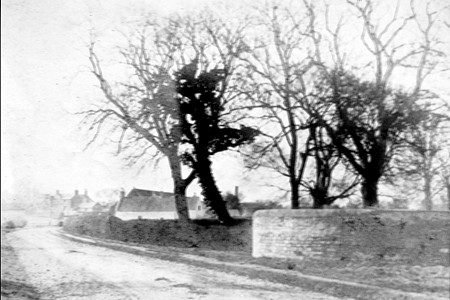|
The pinfold

A pinfold was the name given to an animal pound
where stray livestock such as pigs, sheep and cattle were impounded in a
dedicated enclosure until claimed by their owners, or sold to cover the
costs of impounding.
The village pinfold or pound was a feature of most English mediaeval
villages, the word pinfold being Saxon in origin from pundfald and
pund, both mean an enclosure, and there appears to be no difference
between a pinfold and a village pound although the term pinfold seems to
be more popular in the north and east of England whilst in the south and
west the term pound is more often used.
Their size and shape varied, from a few square feet to more than an acre,
square, rectangular, circular and irregular, provided they fulfilled their
designated purpose of enclosing stray animals.
There was at least one pinfold in Bourne which was situated
to the east of the town in that area around what is now Manning Road.
There was once a Pinfold Lane nearer the town centre which no doubt marked the road to
it but this was changed to Hereward Street in 1899, perhaps because a
newly constituted cattle market was established in the vicinity and the
name was altered to avoid confusion.
There was also an artesian bore which was
situated near the Marquis of Granby public house in Abbey Road, that is
within close proximity to Hereward Street, and was known as the pinfold
spring.
The pinfold was mentioned at the Easter
vestry meeting on Monday 13th April 1868 when the minutes recorded that
"reference was made to the bad state of the pinfold and the opinion
appeared to prevail that if the matter was rightly represented to the lord
of the manor (Lord Exeter) his Lordship would give orders for its being
put into a proper state".
The pinfold was eventually closed although its location is remembered with Pinfold Road,
a narrow lane on at the corner of Manning Road and dating from circa 1970 when
agricultural land was being developed for industrial use, the road today
being occupied by commercial properties and a large waste recycling
centre.
Research by J D Birkbeck (1970) suggests that the name may have been
chosen by the old Bourne Urban District Council because of this
connection. When discussing the Enclosures Act of 1772 he said: "The road
now called Manning Road was in existence and it seems to have been all
part of Meadow Gate Road. Near its junction with Star Lane (now Spalding
Road) was the pound, still surviving from mediaeval times."
References to the Bourne pound or pinfold are few but the Stamford
Mercury did report a case in the Bourne County Court on Tuesday 14th
July 1857 before Judge Edward Cooke which gives an insight into its
activities:
Edward Beckett v John Foster: The amount of
claim was 6s. Plaintiff deposed that both himself and defendant resided at
Dyke, a hamlet of Bourne; that the latter was dike-reeve; that he had
twice tendered him £2 2s. in payment for his two cows going upon the road
sides, but that the money had not been accepted; that he had put the cows
upon the roads, and that they had been ordered by the defendant to be
taken to the Bourne pinfold. Plaintiff came to Bourne and paid the pinder
1s. to relieve the cows. This sum, together with 5s. for his loss of time
in coming to Bourne, he sought to recover from the defendant. At this
point of the proceedings, his honour stopped the case, stating that the
actions would not lie, consequently there must be a non-suit, each to pay
his own costs.

Go to:
Main Index Villages
Index
|
